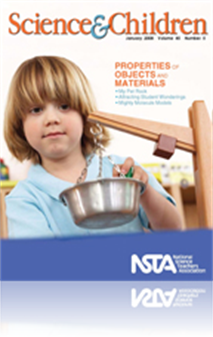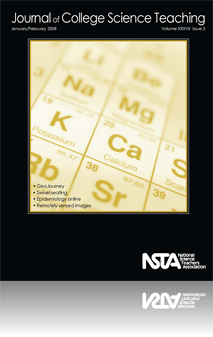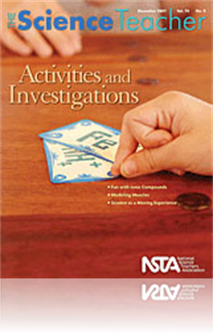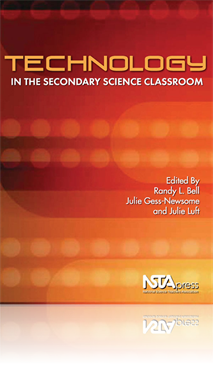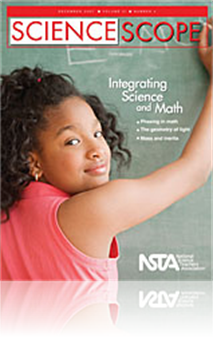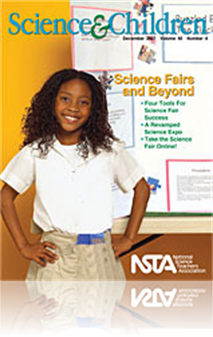All Resources
Journal Article
Science Sampler: Cartoon-initiated conversations
If you are looking to break away from the rut of lab, lecture, film, and notes, cartoon-initiated discussion is for you. You will see student interest and engagement climb due to the novel approach, the empowerment of sharing, and the secure environm...
Journal Article
Science Sampler: A simple assessment solution
This formative-assessment program is based on two key ideas about assessment. First, thoughtful educators use assessment results to revise their instructional approaches so that assessment is no longer a product, but a part of an ongoing process that...
Journal Article
As the authors approached a unit on magnets with their first-grade students, they decided to incorporate more inquiry into their district’s learning module, Magnets: Elementary Science and Technology Module for Primary Grades (State College Area Sc...
Journal Article
Idea Bank: International Polar Year in the Classroom
The International Polar Year (IPY) is one of the most ambitious international science programs ever organized, currently involving over 60,000 scientists from 63 countries. The goal is to broaden humankind’s understanding of the Arctic and Antarcti...
Journal Article
The Early Years: Exploring the Properties of a Mixture
Children learn about properties of materials as they walk through a fabric store, help in the kitchen, or dig in the garden. Directed explorations in the classroom build on these early experiences. In the inquiry-based activity described here, studen...
Journal Article
This article presents a lesson in which students examine current field research on global change. In particular, students investigate the effect of carbon dioxide and tropospheric ozone on ecosystems by applying their knowledge of scientific inquiry ...
Journal Article
The Prepared Practitioner: Intro to Research
As a K-12 teacher, should you pay attention to the research done by “those university people up in their ivory towers?” To understand some of what academic research offers you, an analogy might be helpful. As a driver, you are aided by reporters ...
Journal Article
Cartoons—An Alternative Learning Assessment
In order to fully understand student learning, we science teachers need to know the ideas that students bring into the classroom. Plus, good assessment calls for ongoing evaluation of students’ progress and difficulties with learning on an everyday...
Journal Article
In this study, the authors analyzed how students’ grades in high school biology courses are associated with their predicted and actual grades in college courses. The results of the study revealed a disconnect between high school and college biology...
Journal Article
Space travel, even low Earth orbit, is probably several years away for most of us; however, students and teachers can research the edge of space by participating in the BalloonSat program. BalloonSat is an offshoot of the Space Grant Consortium’s v...
Journal Article
Swivel Seating in Large Lecture Theaters and Its Impact on Student Discussions and Learning
This paper compares two different designs of remodeled, large lecture-theater designs: one with traditional tiered rows and one with swivel seating to facilitate face-to-face discussions during lectures and the impact these designs had on student lea...
Journal Article
Professors of an online graduate-level paleontology class developed the concept of marquee fossils—fossils that have one or more unique characteristics that capture the attention and direct observation of students. In the classroom, Marquee fossils...
Journal Article
Methods and Strategies: Formative Assessment Probes
Formative assessment probes can be effective tools to help teachers build a bridge between students’ initial ideas and scientific ones. In this article, the authors describe how using two formative assessment probes can help teachers determine the ...
Journal Article
In this study, the author examined how attendance in the lab is associated with students’ lab grades and overall course grades in an introductory biology course. Results from this study indicate that academic motivation, as expressed by high rates ...
Journal Article
At RMIT University, students may now elect to study infectious diseases through a course called Outbreak—The Detection and Control of Infectious Disease. Outbreak was designed to simulate in an online class the effective teamwork required to bring ...
Journal Article
Multiple Modes of Inquiry in Earth Science
To help teachers enrich their students’ understanding of inquiry in Earth science, this article describes six modes of inquiry used by practicing geoscientists (Earth scientists). Each mode of inquiry is illustrated by using examples of seminal or ...
Journal Article
From Scooby Doo and Nancy Drew to the countless other detectives that fill children’s bookshelves and television programs, it is clear that children are fascinated with solving crimes. As a result, a chemistry professor who performs outreach activi...
Journal Article
Idea Bank: Connecting Students to Seismic Waves
Have you ever wanted your Earth science students to have a controlled, concrete experience to learn about earthquakes? SeisMac, a free Mac OS X application, can help students develop a concrete foundation for learning about earthquakes. SeisMac turns...
Journal Article
Every Day Science: January 2008
This monthly feature contains facts and challenges for the science explorer. ...
Journal Article
Redefining Earthquakes and the Earthquake Machine
The Earthquake Machine (EML), a mechanical model of stick-slip fault systems, can increase student engagement and facilitate opportunities to participate in the scientific process. This article introduces the EML model and an activity that challenges...
Journal Article
After the Bell: Water harvesting, part 1
The current drought conditions in the United States are correlated with inadequate infrastructure, a drop in the levels of the Great Lakes, desertification, and migration. Taken individually, none of these problems may seem alarming. However, in comb...
Journal Article
Case Study: Introducing Students to Cases
Strategically introducing students to a controversial science case—before they read it, watch it, or listen to it—motivates them to learn from it and paves the way for successful discussion and debate. A strategic introduction also provides an op...
Journal Article
Idea Bank: Ring Species through Space and Time—A Class Demo
Several educators feel that teaching evolution is critical to science education, yet the issue of human evolution is sometimes avoided due to cultural pressures. The class exercise described here was developed to help educators teach this controversi...
Book Chapter
Web-Based Science Inquiry Projects
Web-based inquiry (WBI) learning activities support students as active learners. In these activities, students do not wait for a teacher or someone else to provide an answer. They conduct investigations with meaningful questions about everyday experi...
Book Chapter
Extending Inquiry With Geotechnologies in the Science Classroom
Geotechnologies are tools that allow your students to learn the skills of collecting and analyzing data and creating representations of data with an emphasis on spatial relationships. These processes are critical in nearly every environmental and soc...
Journal Article
Scope on the Skies: The icy fringes
Beyond Neptune and to the edge of the solar system is what is collectively known as the trans-Neptunian region, and objects in this region are sometimes referred to as TNOs. They are considered to be pristine remnants of the early solar system formin...
Journal Article
Four Tools for Science Fair Success
These teacher-tested ideas will guide your students in creating true inquiry-based projects. Two of the ideas, the Topic Selection Wizard and Science Project Timeline, are appropriate for all science fair programs, even new ones. For existing program...
Journal Article
Perspectives: Project-Based Science
I want my fifth graders to tackle bigger science projects that are driven by meaningful and relevant questions. Is project-based science the way to go? ...
Journal Article
Issues In-Depth: Making some bones about it
While most people regard bone as a static entity in our body, this is a serious misconception and one that should be corrected early because bone health is a concern for people of all ages—not just the elderly. While bone tissue is primarily for pr...
Journal Article
Commentary: Reflections from an NSTA High School Committee Member
Membership on the NSTA High School Science Committee has been an “eye-opening and professionally rewarding experience” for Jim Redmond. In this month’s opinion piece, he discusses how his involvement with NSTA and Hawaii’s local chapter, HaST...
Journal Article
Every Day Science: December 2007
This monthly feature contains facts and challenges for the science explorer. ...
Journal Article
The kids in today’s classrooms spend lots of time playing video games, surfing the net, listening to iPods, and text messaging on cell phones. Known as Digital Kids and the Net Generation, they have grown up surrounded by digital media of all types...
Journal Article
Editor’s Note: Science Fairs and Beyond
The rigid nature of most science fairs can cause panic among parents, students, and teachers alike over “doing it the right way.” In this issue, we present alternative views of a standard science fair. These views represent the process of science...
Journal Article
CLSI: Cool Life Science Investigations
With the number of popular medical and forensics programs on television and many references in the media today, even elementary students can comfortably throw around terms such as cells, DNA, and artificial products. However, their questions on th...
Journal Article
A typical card sort is an activity in which students are given a set of cards with a single concept written on each card and asked to organize the cards by grouping related concepts. The nontraditional card sorts described in this article foster crit...
Journal Article
Science Shorts: More Than One Way to Investigate
An exciting element of science fairs is that they give students the opportunity to explore various interests through scientific investigation. Many students, however, mistakenly think that all investigations are experiments. This lesson can help broa...




